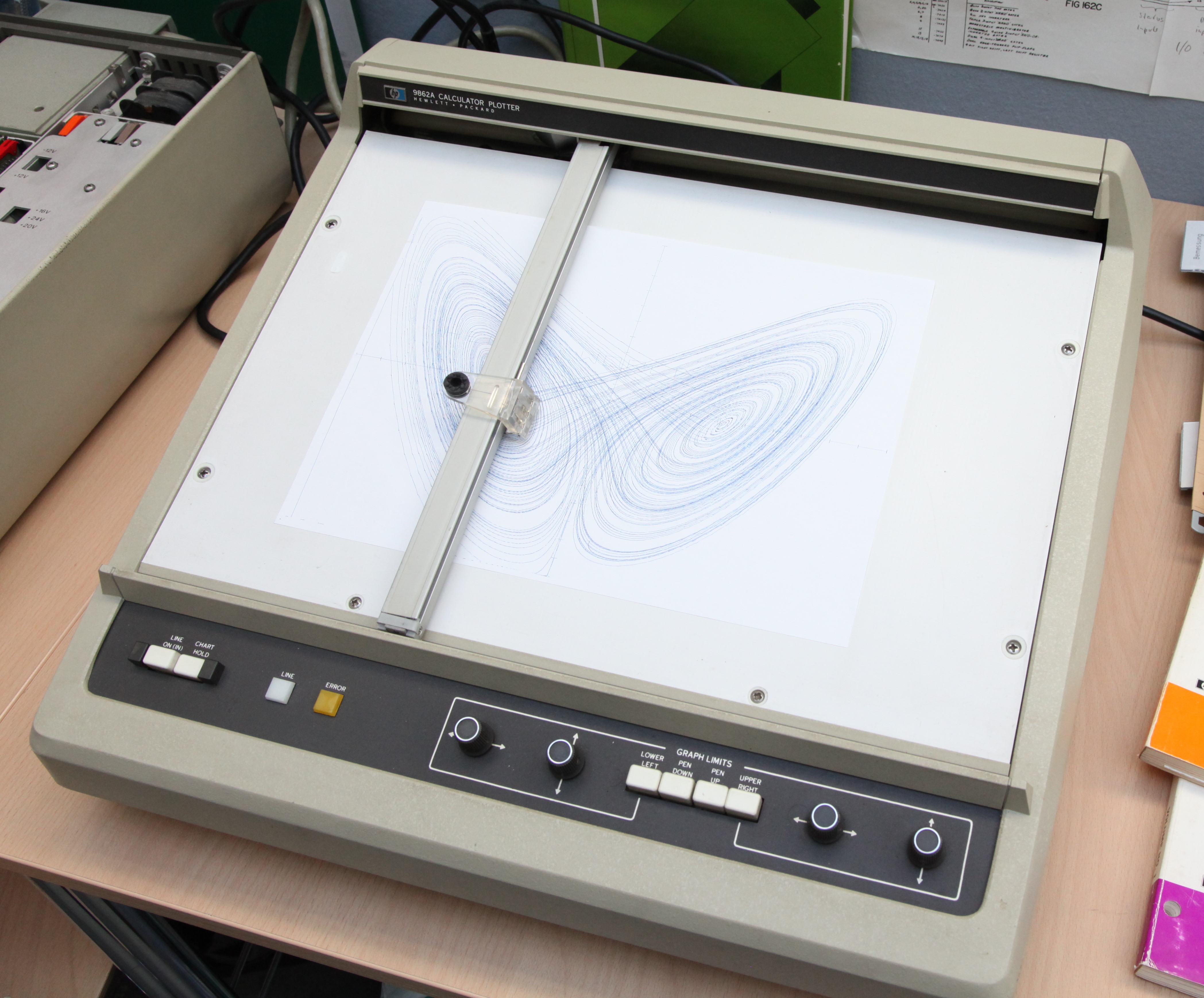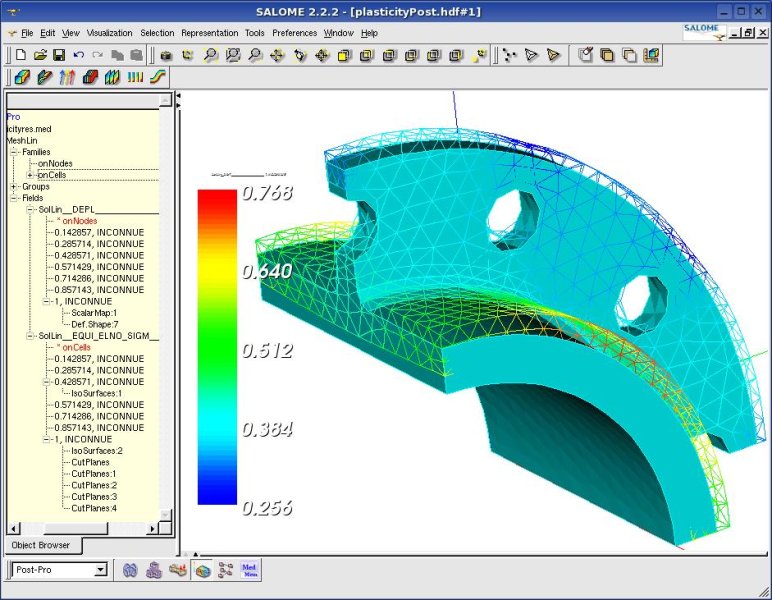|
Electrostatic Plotter
An electrostatic plotter is a type of plotter that draws images on paper with an electrostatic process. They are most frequently used for Computer-Aided Engineering (CAE), producing raster images via either a Liquid Toner or a Dry Toner model. Liquid Toner models use toner that is positively charged and thus becomes attracted to paper's negative charge. This occurs after the toner particles pass through a line of electrodes in the form of tiny wires, or nibs. The spacing of the wires controls the resolution of the plotter; for example, 100 or 400 wires to the inch. Dry Toner models use a process similar to xerography in photocopiers. Unlike a laser printer or photocopier, there is no transfer drum used in most electrostatic plotters; the imaging paper is directly exposed to the charging electrode array. Electrostatic plotters can print in black and white or in color. Some models handle paper sizes up to six feet wide. Newer versions are large-format laser printers and focus light ... [...More Info...] [...Related Items...] OR: [Wikipedia] [Google] [Baidu] |
Plotter
A plotter is a machine that produces vector graphics drawings. Plotters draw lines on paper using a pen, or in some applications, use a knife to cut a material like vinyl or leather. In the latter case, they are sometimes known as a cutting plotter. In the past, plotters were used in applications such as computer-aided design, as they were able to produce line drawings much faster and of a higher quality than contemporary conventional printers. Smaller desktop plotters were often used for business graphics. Printers with graphics capabilities took away some of the market by the early 1980s, and the introduction of laser printers in the mid-1980s largely eliminated the use of plotters from most roles. Plotters retained a niche for producing very large drawings for many years, but have now largely been replaced by wide-format conventional printers. Cutting plotters remain in use in a number of industries. Overview Digitally controlled plotters evolved from earlier fully analog ... [...More Info...] [...Related Items...] OR: [Wikipedia] [Google] [Baidu] |
Computer-Aided Engineering
Computer-aided engineering (CAE) is the broad usage of computer software to aid in engineering analysis tasks. It includes , , , durability and optimization. It is included with computer-aided design (CAD) and computer-aided manufacturing (CAM) in the collective abbreviation " CAx". Overview Computer-aided engineering primarily uses computer-aided design (CAD) software, which are sometimes called CAE tools. CAE tools are used, to analyze the robustness and performance of components and assemblies. CAE tools encompass simulation, validation, and optimization of products and manufacturing tools. CAE systems aim to be major providers of information to help support design teams in decision-making. Computer-aided engineering is used in various fields, like automotive, aviation, space, and shipbuilding industries. CAE systems can provide support to businesses. This is achieved by the use of reference architectures and their ability to place information views on the business proc ... [...More Info...] [...Related Items...] OR: [Wikipedia] [Google] [Baidu] |
Raster Graphics
upright=1, The Smiley, smiley face in the top left corner is a raster image. When enlarged, individual pixels appear as squares. Enlarging further, each pixel can be analyzed, with their colors constructed through combination of the values for red, green and blue. In computer graphics and digital photography, a raster graphic represents a two-dimensional picture as a rectangular matrix or grid of square pixels, viewable via a computer display, paper, or other display medium. A raster is technically characterized by the width and height of the image in pixels and by the number of bits per pixel. Raster images are stored in image files with varying dissemination, production, generation, and acquisition formats. The printing and prepress industries know raster graphics as contones (from ''continuous tones''). In contrast, line art is usually implemented as vector graphics in digital systems. Many raster manipulations map directly onto the mathematical formalisms of linear al ... [...More Info...] [...Related Items...] OR: [Wikipedia] [Google] [Baidu] |
Toner
Toner is a powder mixture used in laser printers and photocopiers to form the printed text and images on paper, in general through a toner cartridge. Mostly granulated plastic, early mixtures only added carbon powder and iron oxide, however, mixtures have since been developed containing polypropylene, fumed silica, and various minerals for triboelectrification. Toner using plant-derived plastic also exists as an alternative to petroleum plastic. Toner particles are melted by the heat of the fuser, and are thus bonded to the paper. In earlier photocopiers, this low-cost carbon toner was poured by the user from a bottle into a reservoir in the machine. Later copiers, and laser printers from the first 1984 Hewlett-Packard LaserJet, feed directly from a sealed toner cartridge. Laser toner cartridges for use in color copiers and printers come in sets of cyan, magenta, yellow and black (CMYK), allowing a very large color gamut to be generated by mixing. Composition, size and ma ... [...More Info...] [...Related Items...] OR: [Wikipedia] [Google] [Baidu] |
Xerography
Xerography is a dry photocopying technique. Originally called electrophotography, it was renamed xerography—from the roots el, ξηρός, label=none ''xeros'', meaning "dry" and -γραφία ''-graphia'', meaning "writing"—to emphasize that unlike reproduction techniques then in use such as cyanotype, the process of xerography used no liquid chemicals. History Xerography was invented by American physicist Chester Carlson, based significantly on contributions by Hungarian physicist Pál Selényi. Carlson applied for and was awarded on October 6, 1942. Carlson's innovation combined electrostatic printing with photography, unlike the dry electrostatic printing process invented by Georg Christoph Lichtenberg in 1778. Carlson's original process was cumbersome, requiring several manual processing steps with flat plates. In 1946, Carlson signed an agreement with Haloid Photographic Company to develop it as a commercial product. Before that year, Carlson had proposed his ... [...More Info...] [...Related Items...] OR: [Wikipedia] [Google] [Baidu] |
Photocopiers
A photocopier (also called copier or copy machine, and formerly Xerox machine, the generic trademark) is a machine that makes copies of documents and other visual images onto paper or plastic film quickly and cheaply. Most modern photocopiers use a technology called ''xerography'', a dry process that uses electrostatic charges on a light-sensitive photoreceptor to first attract and then transfer toner particles (a powder) onto paper in the form of an image. The toner is then fused onto the paper using heat, pressure, or a combination of both. Copiers can also use other technologies, such as inkjet, but xerography is standard for office copying. Commercial xerographic office photocopying was introduced by Xerox in 1959, and it gradually replaced copies made by Verifax, Photostat, carbon paper, mimeograph machines, and other duplicating machines. Photocopying is widely used in the business, education, and government sectors. While there have been predictions that photocopiers ... [...More Info...] [...Related Items...] OR: [Wikipedia] [Google] [Baidu] |
Laser Printer
Laser printing is an electrostatic digital printing process. It produces high-quality text and graphics (and moderate-quality photographs) by repeatedly passing a laser beam back and forth over a negatively-charged cylinder called a "drum" to define a differentially-charged image. The drum then selectively collects electrically-charged powdered ink (toner), and transfers the image to paper, which is then heated to permanently fuse the text, imagery, or both, to the paper. As with digital photocopiers, laser printers employ a xerographic printing process. Laser printing differs from traditional xerography as implemented in analog photocopiers in that in the latter, the image is formed by reflecting light off an existing document onto the exposed drum. Invented at Xerox PARC in the 1970s, laser printers were introduced for the office and then home markets in subsequent years by IBM, Canon, Xerox, Apple, Hewlett-Packard and many others. Over the decades, quality and speed have in ... [...More Info...] [...Related Items...] OR: [Wikipedia] [Google] [Baidu] |
Photocopier
A photocopier (also called copier or copy machine, and formerly Xerox machine, the generic trademark) is a machine that makes copies of documents and other visual images onto paper or plastic film quickly and cheaply. Most modern photocopiers use a technology called ''xerography'', a dry process that uses electrostatic charges on a light-sensitive photoreceptor to first attract and then transfer toner particles (a powder) onto paper in the form of an image. The toner is then fused onto the paper using heat, pressure, or a combination of both. Copiers can also use other technologies, such as inkjet, but xerography is standard for office copying. Commercial xerographic office photocopying was introduced by Xerox in 1959, and it gradually replaced copies made by Verifax, Photostat, carbon paper, mimeograph machines, and other duplicating machines. Photocopying is widely used in the business, education, and government sectors. While there have been predictions that photocopiers ... [...More Info...] [...Related Items...] OR: [Wikipedia] [Google] [Baidu] |
Laser Printers
Laser printing is an electrostatic digital printing process. It produces high-quality text and graphics (and moderate-quality photographs) by repeatedly passing a laser beam back and forth over a negatively-charged cylinder called a "drum" to define a differentially-charged image. The drum then selectively collects electrically-charged powdered ink (toner), and transfers the image to paper, which is then heated to permanently fuse the text, imagery, or both, to the paper. As with digital photocopiers, laser printers employ a xerographic printing process. Laser printing differs from traditional xerography as implemented in analog photocopiers in that in the latter, the image is formed by reflecting light off an existing document onto the exposed drum. Invented at Xerox PARC in the 1970s, laser printers were introduced for the office and then home markets in subsequent years by IBM, Canon, Xerox, Apple, Hewlett-Packard and many others. Over the decades, quality and speed have i ... [...More Info...] [...Related Items...] OR: [Wikipedia] [Google] [Baidu] |
Lasers
A laser is a device that emits light through a process of optical amplification based on the stimulated emission of electromagnetic radiation. The word "laser" is an acronym for "light amplification by stimulated emission of radiation". The first laser was built in 1960 by Theodore H. Maiman at Hughes Research Laboratories, based on theoretical work by Charles Hard Townes and Arthur Leonard Schawlow. A laser differs from other sources of light in that it emits light which is coherence (physics), ''coherent''. Spatial coherence allows a laser to be focused to a tight spot, enabling applications such as laser cutting and Photolithography#Light sources, lithography. Spatial coherence also allows a laser beam to stay narrow over great distances (collimated light, collimation), enabling applications such as laser pointers and lidar (light detection and ranging). Lasers can also have high temporal coherence, which allows them to emit light with a very narrow frequency spectrum, spectr ... [...More Info...] [...Related Items...] OR: [Wikipedia] [Google] [Baidu] |
LEDs
A light-emitting diode (LED) is a semiconductor device that emits light when current flows through it. Electrons in the semiconductor recombine with electron holes, releasing energy in the form of photons. The color of the light (corresponding to the energy of the photons) is determined by the energy required for electrons to cross the band gap of the semiconductor. White light is obtained by using multiple semiconductors or a layer of light-emitting phosphor on the semiconductor device. Appearing as practical electronic components in 1962, the earliest LEDs emitted low-intensity infrared (IR) light. Infrared LEDs are used in remote-control circuits, such as those used with a wide variety of consumer electronics. The first visible-light LEDs were of low intensity and limited to red. Early LEDs were often used as indicator lamps, replacing small incandescent bulbs, and in seven-segment displays. Later developments produced LEDs available in visible, ultraviolet (UV) ... [...More Info...] [...Related Items...] OR: [Wikipedia] [Google] [Baidu] |






